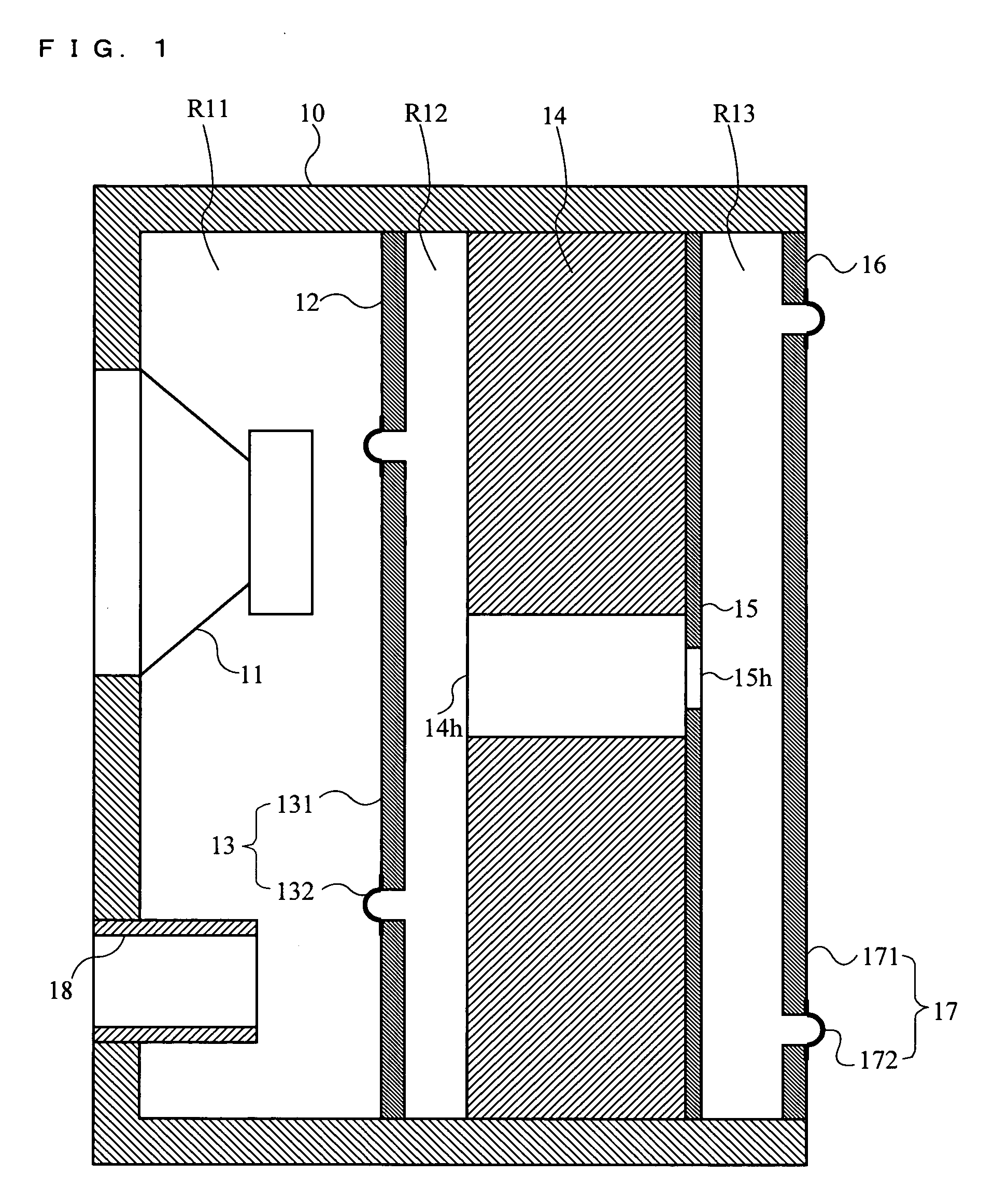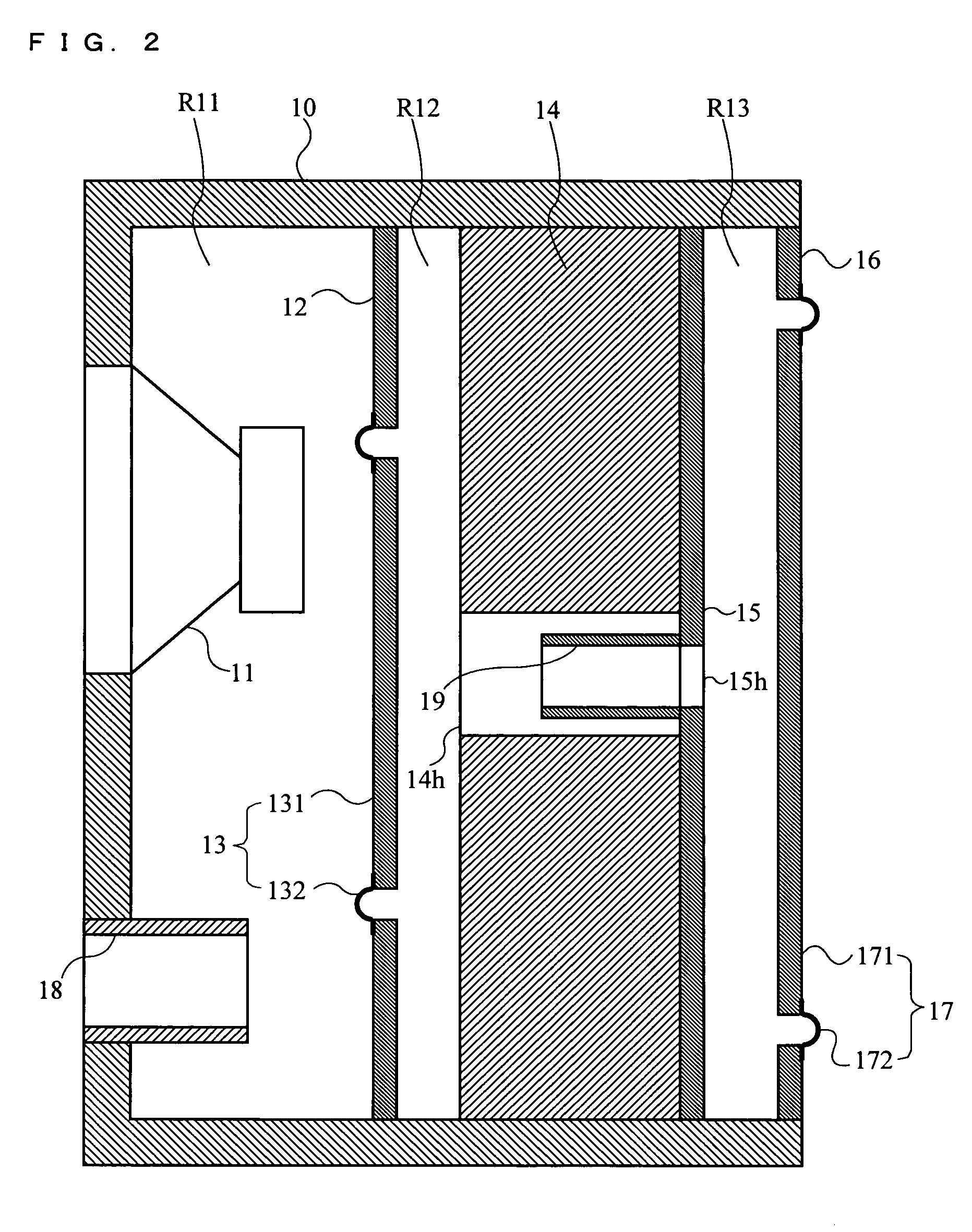Speaker system
a speaker system and speaker technology, applied in the field of speaker systems, can solve the problems of small speaker systems that have difficulty in realizing a speaker system capable of satisfactory bass reproduction, and achieve the effects of improving sound quality, reducing pressure variation in the sealed chamber, and increasing volume of sealed spa
- Summary
- Abstract
- Description
- Claims
- Application Information
AI Technical Summary
Benefits of technology
Problems solved by technology
Method used
Image
Examples
first embodiment
[0055] A speaker system according to a first embodiment of the present invention is described with reference to FIG. 1. FIG. 1 is a cross-sectional view illustrating a structure of a speaker system according to the first embodiment.
[0056] In FIG. 1, the speaker system includes a cabinet 10, a speaker unit 11, a first parting board 12, a drone cone 13, an adsorption member 14, a second parting board 15, a backboard 16, a variable mechanism 17, and a port 18. As shown in FIG. 1, the speaker system according to the first embodiment is a phase inversion type speaker.
[0057] The cabinet 10 is defined by a front face, upper face, bottom face, and left and right side faces of a housing of the speaker system. The speaker unit 11 is a dynamic speaker, for example. The speaker unit 11 is attached to an opening formed in the front of the cabinet 10 such that a sound emission surface of the speaker unit 11 faces an exterior of the cabinet 10. The backboard 16 including the variable mechanism 1...
second embodiment
[0081] A speaker system according to a second embodiment of the present invention is described with reference to FIG. 3. FIG. 3 is a cross-sectional view illustrating a structure of a speaker system according to the second embodiment.
[0082] In FIG. 3, the speaker system includes a cabinet 20, a speaker unit 21, an adsorption member 24, a backboard 26, and a variable mechanism 27. As shown in FIG. 3, the speaker system according to the second embodiment is a closed enclosure type speaker. The speaker unit 21, the first parting board 25, and the backboard 26 in the second embodiment have the same functions as the speaker unit 11, the second parting board 15, and the backboard 16 in the first embodiment, respectively. Thus, detailed descriptions thereof are omitted here. The adsorption member 24 is similar to the adsorption member 14 in the first embodiment except that these adsorption members have different shapes.
[0083] The cabinet 20 is defined by a front face, upper face, bottom ...
third embodiment
[0102] A speaker system according to a third embodiment of the present invention is described with reference to FIG. 5. FIG. 5 is a cross-sectional view illustrating a structure of a speaker system according to the third embodiment.
[0103] In FIG. 5, the speaker system includes a cabinet 30, a speaker unit 31, an adsorption member 34, a backboard 36, and a variable mechanism 37. As shown in FIG. 5, the speaker system according to the third embodiment is a closed enclosure type speaker having a chamber R31 enclosed by the cabinet 30 and the backboard 36. The speaker unit 31 and the backboard 36 in the third embodiment have the same functions as the speaker unit 11 and the backboard 16 in the first embodiment, respectively. Thus, detailed descriptions thereof are omitted here. The adsorption member 34 is similar to the adsorption member 14 in the first embodiment except that these adsorption members have different shapes.
[0104] The cabinet 30 is defined by a front face, upper face, b...
PUM
 Login to View More
Login to View More Abstract
Description
Claims
Application Information
 Login to View More
Login to View More - R&D
- Intellectual Property
- Life Sciences
- Materials
- Tech Scout
- Unparalleled Data Quality
- Higher Quality Content
- 60% Fewer Hallucinations
Browse by: Latest US Patents, China's latest patents, Technical Efficacy Thesaurus, Application Domain, Technology Topic, Popular Technical Reports.
© 2025 PatSnap. All rights reserved.Legal|Privacy policy|Modern Slavery Act Transparency Statement|Sitemap|About US| Contact US: help@patsnap.com



